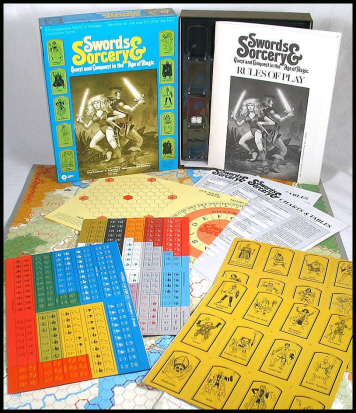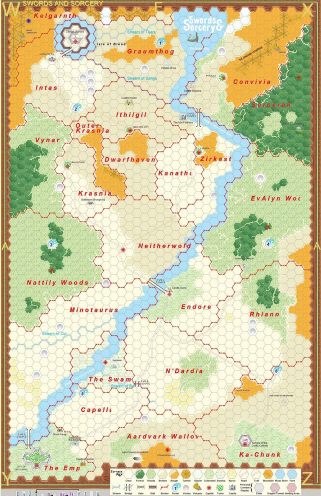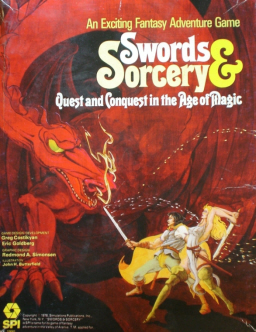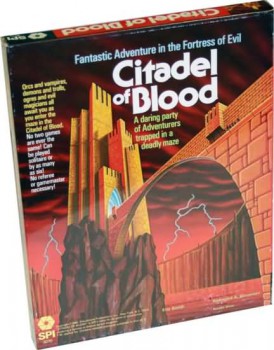Vintage Treasures: SPI’s Swords and Sorcery

Well, technically it’s not a new treasure, since it was first published in the late Middle Ages of fantasy gaming (1978). But this copy is new to me, courtesy of eBay.
And just look at it. Isn’t it gorgeous?
Okay, so maybe you’re not into vintage fantasy games the way I am (that shout you hear is my long-suffering wife, saying “Like that’s even possible.”) Or maybe you find the flimsy paper maps and counters of older board games a little quaint, compared to the deluxe contemporary offerings from Fantasy Flight and Wizards of the Coast.
But really, you just have to open the Swords and Sorcery box to know it’s something special. 400 counters, 56 playing cards, a big 56-page rulebook, player aids, a tantalizingly complex Diplomacy Display… and best of all, that beautiful map.
Yeah, maybe it’s a little shallow to fall in love with a game because of a map. But really, isn’t a cool setting at the heart of all great fantasy?
And the setting for Swords and Sorcery isn’t just cool. It’s sumptuous.
Now, maybe when you sit down to play a quick game on a rainy day with your cousin from Thunder Bay, you prefer to move your pieces across a clean, abstract board, like chess. Or Stratego. Or maybe Risk, with its crude approximation of the continents.

Or perhaps you’re like me, and you want your dwarven armies to storm the gates of the Citadel of Blood, or penetrate sinister forests to the Temple of the Corflu Cultists. Or send Theregond the Mage and Linfalas the Elf to explore the Tombs of the Damned, or regroup in Aardvark Wallow. Those are just a few quiet corners of the map in Swords and Sorcery.
Of course, names on a map are just so much window dressing without real context in the game. And that’s where the scenarios come in.
Swords and Sorcery is actually two different products: an Army Game, which plays like a richly detailed wargame in a fantasy setting, and a Quest Game, which is really more of an RPG. There are fourteen scenarios in the Army Game covering several centuries in total, from The Rise of the Dark Lord (in 473 AF) to The Orcish Revolution (794 AF) to The War of the Northern Kingdoms (867 AF). Each has a detailed history and back story and involves a different mix of armies, characters, magical artifacts, set up instructions, and of course victory conditions.
The Army Game, as you may imagine, is for gamers whose eyes light up at the sight of hundreds of tiny counters, and who expect to set aside 4-6 hours (or a maybe a weekend or two) to experience a complete campaign.
Campaigns, or linked scenarios, simulate pivotal moments in the detailed history of the world, involving a huge cast of characters. Here’s a brief description from Steve Mariner’s excellent Sword & Sorcery page:
Swords & Sorcery is simply one of the most enjoyable games I’ve ever played….The Army game, however, is a work of art. Wonderfully integrated into the already well-developed movement and combat systems… is a system of magic, with interesting spells to affect things on the map (demoralize enemy troops, rally friendly troops, conjure extra troops, cause a sudden winter) and a mathematical mechanism for using magic to directly affect combat.
The game comes complete with an entirely fictional history for the world and the characters in it, and the scenarios fit right into the historical timeline. There are Elves, three nations of Dwarves, three political varieties of Humans, Two nations of Orcs, an unusual race called the Cronks, which are large, hairy, orange apes that smell terribly and can apparently live for up to two weeks on nothing but dirt, giant Spider-Folk, a nation of Swamp-Creatures which includes in its military muster a species of intelligent mold, and, of course, a nation of Dragons headed by none other than Gygax Dragonlord himself.

Any game featuring a cameo by Dungeons and Dragons co-creator Gary Gygax is okay in my book. (Bear in mind Swords and Sorcery was released in 1978, barely four years after D&D, and Gygax was hardly a household name. It was much more of an in-joke in those days, let me tell you).
The Quest Game is an entirely different matter from the Army Game, and can be set up and played a lot more quickly. Each player takes the role of one of the famous historical figures provided (or generates a new character), then draws a random quest that sends her scampering across the board, exploring dangerous sites and resolving encounters. There are powerful artifacts to be found, monsters to be vanquished, and potent villains to be overcome.
Sound familiar? The role playing elements of Swords and Sorcery were satisfying enough that, when I first grew curious about RPGs in high school, I was told by older students that there were only two choices for serious gamers: D&D and Swords & Sorcery (and at least a few strongly preferred the latter.)
The game includes a dozen pre-generated quests, from a desperate attempt to stop Narklath the Wraithlord (“King of the Undead”) to a lengthy contest to win the hand of the beautiful Princess Elena in marriage (“Beauty and the Beasts.”)
Of course, the other players may thwart your plans just as you get close to your goal, and the rule book thoughtfully includes hand-to-hand combat rules for those special moments when you need to bean your cousin with your brand new Kravensbane mace.
There are plenty of nice touches in the rule book, including detailed back-stories for each of the characters (and even the monsters), optional rules for merging the Quest and Army games, and adding things like wandering monsters.
 Swords and Sorcery was created by legendary game designer Greg Costikyan relatively early in his career. While it’s clearly a product of its time — owing a huge debt to Tolkien for, well, just about everything, including the race histories and the entire story structure — it also has enough original touches to give the game a distinct flavor.
Swords and Sorcery was created by legendary game designer Greg Costikyan relatively early in his career. While it’s clearly a product of its time — owing a huge debt to Tolkien for, well, just about everything, including the race histories and the entire story structure — it also has enough original touches to give the game a distinct flavor.
Costikyan’s later works include some of the most fondly-remembered RPGs and board games of the era, including Paranoia, Star Wars: The Roleplaying Game, Toon, and The Creature That Ate Sheboygan.
He returned to the setting of Swords and Sorcery in 1980 for the standalone game Citadel of Blood, which was originally published in Ares Magazine #5, SPI’s superb (but sadly short-lived) publication devoted to science fiction and fantasy gaming.
(Which reminds me, I really need to write a blog post on Ares one of these days. If ever there was a topic tailor made for the Black Gate blog, it’s Ares magazine.)
Citadel of Blood was set in the northwest corner of the Swords and Sorcery map, and allowed a party of adventurers to venture into the stronghold of the evil mage “X the Unknown,” one of the parent game’s more memorable villains.
It added a few more RPG elements, like the ability to gain experience by fighting monsters. The game board was randomly generated during play using tiles, which added to re-play value, and the game culminated with players finding and destroying X himself — assuming they get that far.
One of the most interesting things about Swords and Sorcery is that, for all its vaulted reputation among knowledgeable fans, it’s not particularly well remembered. But it sold well in its day, and went through several editions, which means that copies aren’t all that scarce. At any given time I can usually find at least one or two for sale on eBay, often at decent prices.
And that means you can pick up a brand new, unpunched version of the game for only slightly more than you’d expect to pay for a comparatively-sized fantasy game today, like Ikusa and the epic Conquest of Nerath. Truly, life is good.
If you happen to come across one in your travels, don’t let the opportunity to try Swords and Sorcery pass you by. In fact, haunt online auctions until you snag one if you have to.
Just don’t expect me to sell my copy.
That game does look awesome. I usually don’t hear good things about the games SPI produced but this seems very interesting
Thanks Glen! Odd that you don’t hear good things about SPI… they produced literally hundreds of board games in the 70s and 80s, including some real classics. Maybe they’re an acquired taste, but give them a chance.
SPI in their context were revolutionary and ground-breaking. Redmond Simonsen brought art to maps and player’s aids, and the standardized rules format was a breakthrough at the time, lending order to very complex rules systems. This is what allowed SPI to produce table-top rules for just about anything and set the stage for future graphics artists–such as those used in FFG and WoC products.
I cherish their attempts at fantasy. I have original Ares editions of Ragnarok and Albion…both IMHO exemplary for map based games. Please do a blog on Ares!
And please remember SPI were the first (at least in the US) to publish a Lord of the Rings board game. Complete with folio games for Gondor and Sauron (the Battle of Dagoriad where the ring was lost to Sauron).
However RPGs were a later specialty, but DragonQuest and Universe are both solid, if complicated games.
Anyway, cut my teeth on SPI and had to comment! Cheers! Norm
I forgot DragonQuest was SPI. After my game group had used science fiction games — which had skills — when we returned to fantasy we went to DragonQuest rather than going back to AD&D. I remember it being simpler than AD&D. Fewer charts, for one thing, and a simplified professions list, and a few other changes we seemed to think were pretty nifty that I no longer recall. If memory serves, TSR bought it and killed it…
Sounds like a pretty tough game to play if it has up to 400 counters. Amazing people even have the space to play such a thing. ^^
Hope your Black Gate #16 editorial is as good as this article. 🙂
Hi nlfenlason,
> I have original Ares editions of Ragnarok and Albion… both IMHO exemplary for
> map based games. Please do a blog on Ares!
Thanks for the encouragement. I’d love to, but I need to make sure I do it justice. It will take some planning.
And ah, Albion! One of my favorites of the entire Ares line (except perhaps BARBARIAN KING. And maybe STAR TRADER. And NIGHTMARE HOUSE. And…) Boy, that was a great line of games.
> And please remember SPI were the first (at least in the US) to publish a Lord of
> the Rings board game. Complete with folio games for Gondor and Sauron (the
> Battle of Dagoriad where the ring was lost to Sauron).
Oh, I haven’t forgotten. One of the most memorable gaming sessions I’ve ever had was an epic three-player match of SPI’s WAR OF THE RING. I played Saruman, and led Sauron to defeat at the gates of Minas Tirith through an act of base treachery. Ah, I get misty-eyed just thinking about it.
Glad you enjoyed the article.
> I forgot DragonQuest was SPI. After my game group had used science fiction games — which
> had skills — when we returned to fantasy we went to DragonQuest rather than going back to AD&D.
Hey Howard!
And I forgot you were a DragonQuest man. Yeah, it was a nifty system.
> If memory serves, TSR bought it and killed it…
Sadly, yes. Although TSR actually released a heavily revised 3rd edition before they killed it, and for a while it was beginning to look like they would keep it alive.
They also killed Ares — and the proud wargames line, after they bought SPI. Ah, TSR. You have much to answer for.
Hi Alex,
> Sounds like a pretty tough game to play if it has up to 400 counters. Amazing people even have the space to play such a thing.
Uh, yeah. That’s a good point. You really needed an entire kitchen table for this thing. More than one epic fantasy game in my childhood was prematurely terminated because Mom stood over our shoulders tapping her foot, ready to set the table for dinner.
Of course, now I have all the space I need, but my fellow gamers are scattered across the country (or in Canada). It’s a familiar story.
> Hope your Black Gate #16 editorial is as good as this article.
Thanks (I think). Way to put the pressure on. 🙂
In layout, design and colors, and size, too, this looks complementary to SPI’s ‘War of the Ring’ game.
Another game I hardly played but should have kept, anyway. *sigh*
While it is easy to blame TSR for what they did to SPI — and they deserve a lot of blame — one should keep two things in mind.
First, when they purchased SPI it was in dire financial straights and would likely not have survived.
Second, they had hoped to keep SPI’s staff, but those staff members refused to work for TSR — for varied reasons — and left to form the Victory Games studio over at Avalon Hill.
Third, and this is where I get near heretical, it was the Blumes who devalued SPI’s contributions. A massive resurgence of publishing of SPI games happened under Lorraine Williams. We would never have seen the SPI monster TSR World War II game, or Wellington’s Victory, SNIPER (including BugHunters), let alone the 3rd edition of DragonQuest.
I believe she did the publishing of SPI stuff out of desperation, not any love for the product or the fans, as TSR was starting to have financial troubles which could only be met by an ever expanding publication schedule and continual revenue flow.
It was the Blumes who refused to acknowledge lifetime subscriptions to SPI magazines.
There is an excellent issue of Fire and Movement, printed by Steve Jackson Games, that goes over the purchase of SPI.
Oh…it should also be noted that DragonQuest was the game that inspired the Chronicles of the Raven series of books.
pmcnamee67,
> In layout, design and colors, and size, too, this looks complementary to SPI’s ‘War of the Ring’ game.
Very much so, I think. WAR OF THE RING was published one year earlier (1977), but the components (map, cards, counters, etc) were very similar.
It’s clear in hindsight, I think, that WAR OF THE RING — which was a huge hit for SPI, even winning the Charles S. Roberts Award that year — inspired SPI to create more fantasy games with a similar scope.
The Tolkien influence on SWORDS & SORCERY is very obvious, and the fact that the components of the two games are so similar is no coincidence.
Christian,
> While it is easy to blame TSR for what they did to SPI — and they deserve a lot of blame — one should keep two things in mind.
Very well said.
It’s easy to think that TSR killed SPI, but evidence seems to suggest they were struggling well before TSR acquired them.
And I’ve heard similar stories about the Blumes — though mostly from biased sources (chiefly Gygax and his allies), so I tend to take them with a grain of salt.
> There is an excellent issue of Fire and Movement, printed by Steve Jackson Games, that goes over the purchase of SPI.
Really? Well worth tracking it down. Do you know what issue it is?
> it should also be noted that DragonQuest was the game that inspired the Chronicles of the Raven series of books.
Also news to me! Thanks for letting me know.
John,
I’ll track down the issue of Fire & Movement. It’s a good read and is written just as the SPI acquisition occured.
Oh, and you might want to look at Issue #60 of Space Gamer. It has a brief discussion of a TSR visit with Heritage Models. It seems that they wanted to buy Heritage, but that the conversations didn’t go well.
It should be noted that Space Gamer was as anti-TSR as anyone today is anti-Lorraine. Oh, and while the issue of F&M was published by anti-TSR SJG, the article is extremely balanced.
Space Gamer also had a smack down with SPI when they reviewed Swords & Sorcery…I’ll track down the couple of issues where that dialogue takes place.
The Space Gamer issues should be available from SJG as pdfs.
Thanks Christian!
[…] month I wrote a lengthy blog post about Sword & Sorcery, a lavish fantasy board game published by SPI over three decades ago. In the comments section the […]
[…] That might be a generous description of Church’s map. It’s certainly colorful and reflective (more or less) of the geography Moorcock created, but it looks more like a Risk map than the gorgeous fantasy landscape of something like SPI’s Sword & Sorcery. […]
[…] line of Tolkien-inspired games, the most successful of which was Greg Costikyan’s sumptuous Swords & Sorcery, in […]
[…] lift of sorts from a SPI fantasy ‘verse that premiered in one of my favorite SPI games ever, Swords and Sorcery. S&S was a giant sprawling boardgame/roleplaying game construct of a sort that SPI excelled in- […]